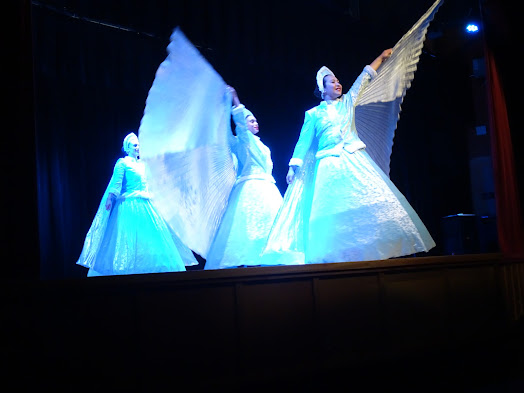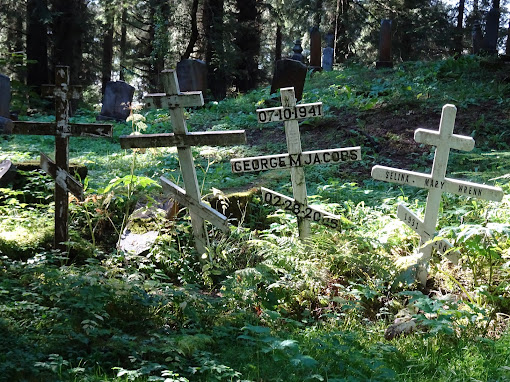Today we arrived in the lovely town of Sitka, that has a population of 8,500.
The Russian explorers settled here in 1799, naming it Fort Archangel Michael. The Russian American Company was a colonial trading company which was attacked by the native Tlingit who destroyed the original settlement, killing many of the Russians living there in 1802.
The Russians returned in 1804 and eventually defeated the Tlingit and renamed the settlement, "New Archangel" and was designated the new capital of Russian America.
We had a bit of a bus ride around town, and we had a rather wonderful dance presentation that outlined Sitka's history.
After that we went to walk around the town. It was so well set up for tourists. We walked through a temperate rainforest and then crossed a river where the salmon were running and many of whom were being picked off by birds of prey. I wasn't too worried about bears, given that we had just seen about 300 teens run through the woods as part of the Sitka Invitational Run.
All those fish and no fishing rod.
We were taught on the bus that there were five types of salmon in Alaska. These are Chum, Sock-eye, King, Silver and Pink. Here below, there are two types...dead and not dead yet.
We found our way to the Raptor Centre. Here they rehabilitate birds of prey back into the wild if they can. They are injured as the result of car accidents, electrocution, fighting each other or being shot at. For animals they intend to release back into the wild, they limit human contact, so they are behind a one-way mirror, and they use a small waterfall to mask sounds of human activity. It was all very clever.
This is a Northern Goshawk. They are quite shy and don't like being near humans. The carers had us come over quietly to observe her feeding her. This one was shot after it got into a chicken coop.
This beautiful specimen is a Grey Northern Owl. The photo does not do him/her justice.

This Snowy Owl has been given some food wrapped up to make it more interesting for him. He didn't seem to want us to see him open and eat it. It was a rat's head so I can understand his reluctance. Or maybe he is just stupid.
They did have several bald eagles in residence, and they really are quite magnificent animals.
It was a really nice experience.
We walked back into town and found the National Cemetery. This contained the burials of former US service men and women. I thought this was an area that WW2 would have figured very prominently but the graves varied from the Indian Wars through to the Korean War and some with their wives.
We came across one grave at random, a Captain Charles William Paddock USMC and with a minimum of research we discovered that he was an Olympic gold medalist from the 1920 Olympic games. He was the first person to be described as "The Fastest Man on Earth" and his "100m" record stood until 1956. He was killed in an air accident during WW2. He was portrayed in the 1981 film Chariots of Fire, and although it was the third Olympics he competed in, he was not in the final.
We also found the Russian Orthodox Cathedral of St Michaels's church built in 1841 but unfortunately it was burnt down in 1966 but rebuilt.
A reconstructed Russian blockhouse that was part of the fortified wall.
The site of the Russian cathedral that was dismantled on the site.
We also ventured into a very dark and damp rainforest on a pretty sketchy track, and it was a bit spooky. I thought if we didn't come across the Russian cemetery soon, we would turn back. It was at first very difficult to see but we did find some graves off the track.
THe Russian cemetery is over 200 years old and contains 1,600 graves. As we ventured further in the canopy lightened and we saw many more graves. Some of them did not have particularly Russian sounding names but i suspect that they had strong Russian links so opted to be buried here.
We visited the museum which was small but had quite good exhibits detailing the First Nations occupation and the Russian colonisation, followed by the US ownership after they purchased Alaska from the Russians.
The Prince and Princess Maksoutoff. He was the last Russian Governor who handed over Alaska to the US when the Americans purchased it for 2 cents an acre. His wife died several years later, aged 36 and her body was bought back and buried in the Russian cemetery.
What the settlement looked like under the Russians.
Russian Orthodox aretefacts ,although maybe not the saw on the left.
We returned to the ship by shuttle bus. Our driver Linda told us that Mount Edgecombe off the coast is an inactive volcano. It hasn't erupted for 4,000 years. One of the locals took a shipment of tyres and was going to burn them over there so they produced this very thick black smoke. He had told the police and the airport but forgot to tell the Coastguard. He lit the tyres and apparently it was the best April Fool's joke the town has ever had.
We returned to the ship to see some whale spout in the distance. Essentially if you can't see them near the ship, then there isn't much point.
We saw an interesting presentation on glaciers this evening. Apparently, some glaciers are pink which means there is algae growing in them and that also means that there is a worm in the ice that eats algae.



















No comments:
Post a Comment